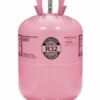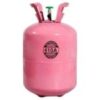Description
Refrigerant Gas R-32, R-410 primary function is to facilitate the transfer of heat from inside the building to the outdoors. In the cooling cycle, the gas absorbs heat from indoor air, becomes high-pressure, high-temperature gas, releases heat outdoors and becomes low-pressure gas again. This maintains a cool indoor environment.
Types Of Gases
a. Hydrochlorofluorocarbons (HCFCs): Historically used refrigerant gas, HCFCs like R-22 were common. However, due to their ozone-depleting potential, their use has been phased out in many countries.
b. Hydrofluorocarbons (HFCs): HFCs such as R-410A and R-134a, are widely used. While they have zero ozone-depleting potential, some HFCs have high global warming potential (GWP), leading to ongoing efforts to find more environmentally friendly alternatives.
c. Hydrofluoroolefins (HFOs): Emerging as eco-friendly alternatives, HFOs like R-1234yf have low GWP and adopted to mitigate environmental impact.
d. Natural Refrigerants: Ammonia (R-717), carbon dioxide (R-744), and hydrocarbons (R-290, R-600a) are gaining popularity as natural alternatives due to their low GWP and environmental friendliness.
e. Hydrofluorocarbon (HFC): R-32, has gained prominence as a more environmentally friendly alternative to its predecessors. R-32 aligns with the industry’s commitment to reducing environmental impact.
f. R-410A is the industry workhorse prevalent in various air conditioning systems, including central air conditioners, heat pumps, and ductless mini-split systems, balancing performance and environmental responsibility.
g. R-32 commonly used in split-type air conditioners and heat pumps, where its low GWP and high energy efficiency contribute to sustainable and effective cooling and heating.














Reviews
There are no reviews yet.